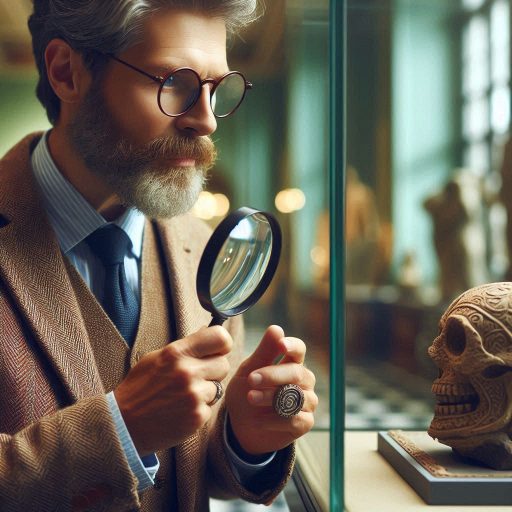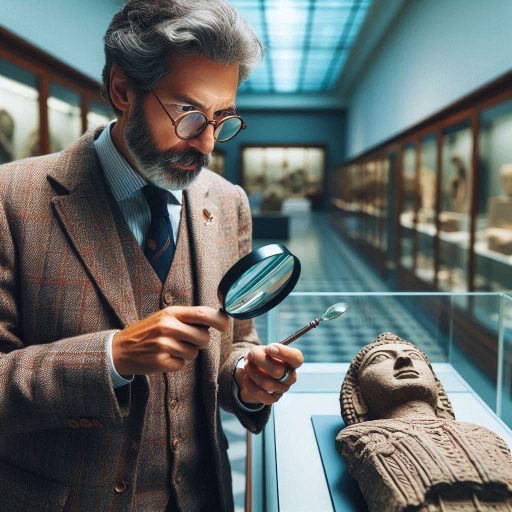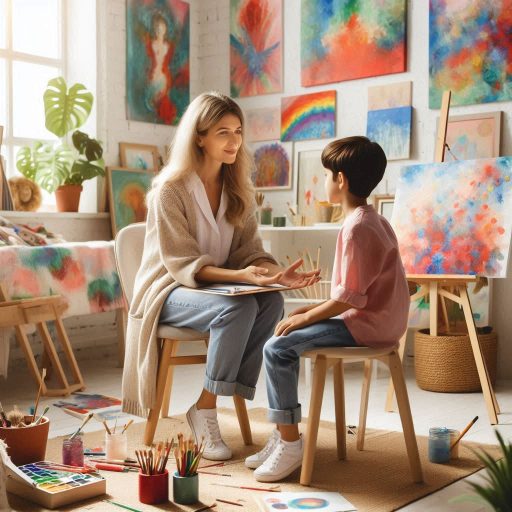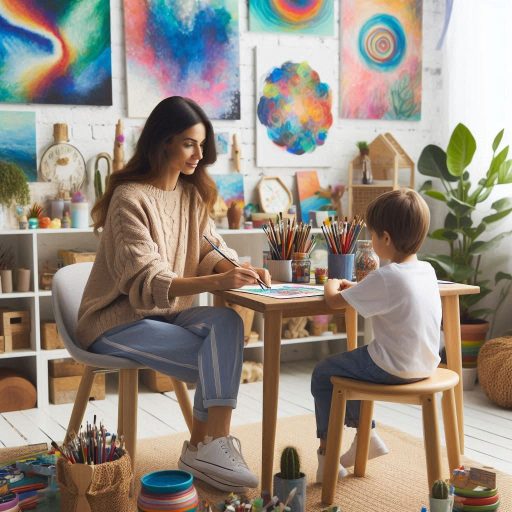Introduction
Museum curation is the process of selecting, organizing, and presenting artworks and artifacts in a way that engages and educates the public.
Curators play a vital role in interpreting collections, designing exhibitions, and creating meaningful experiences for visitors.
They serve as the bridge between the artifacts and the audience, ensuring that the stories behind the objects are effectively communicated.
Understanding the history of museum curation is essential for several reasons.
Firstly, it provides insight into how cultural institutions have evolved over time.
The practices and philosophies of curation reflect societal values and historical contexts.
By studying these changes, we can better appreciate the challenges and innovations that have shaped museums today.
Additionally, examining the history of curation reveals the impact of various factors, such as colonialism, technological advancements, and shifting audience expectations.
These influences continue to inform current practices and guide future trends.
Understanding this evolution allows curators and museum professionals to make informed decisions.
They can honor cultural heritage while addressing diverse audience needs.
In essence, a comprehensive understanding of museum curation’s history enriches the field, fostering growth, inclusivity, and relevance in an ever-changing world.
Early history of museum curation
Origins of Museums and Collections
Museum curation has its roots in ancient civilizations, where early collections of objects were displayed.
The origins of museums trace back to private collections of wealthy individuals, often referred to as “cabinets of curiosities.”
These collections were not open to the public but served as repositories of knowledge and status symbols.
Ancient Greeks and Romans created temples and sanctuaries to house objects of religious and cultural importance.
For example, the Temple of Artemis in Ephesus and the Roman Forum displayed statues and treasures.
These early forms of curation were centered on religious artifacts, cultural relics, and items that held significant value.
The Renaissance period marked a turning point, as curiosity about the natural world grew.
Wealthy patrons and explorers collected rare and exotic objects from around the globe.
These collections laid the foundation for modern museums.
By the 17th century, European rulers and aristocrats amassed large collections of art, manuscripts, and natural specimens.
This period saw the rise of dedicated spaces for displaying these collections, though public access remained limited.
Role of Collectors and Scholars in Organizing and Displaying Artifacts
During the early stages of museum curation, collectors played a pivotal role in organizing and displaying artifacts.
Collectors, often noblemen or scholars, gathered items based on personal interests or cultural significance.
The primary goal was to showcase knowledge, wealth, and power.
Their private collections often included works of art, scientific instruments, rare books, and specimens from natural history.
Scholars became essential figures in early curation efforts, as they provided the intellectual framework for organizing these objects.
In the 17th and 18th centuries, scholars created systems for cataloging and classifying objects.
This methodical approach was crucial in transforming random collections into organized displays with educational value.
Natural history collections, in particular, benefited from the work of scholars who categorized specimens according to emerging scientific principles.
For example, Sir Hans Sloane, an English physician and collector, amassed a vast collection of natural history items and cultural artifacts.
His collection became the foundation of the British Museum, which opened to the public in 1759.
Similarly, the Ashmolean Museum in Oxford, founded in 1683, emerged from the collection of Elias Ashmole.
Scholars and collectors like Sloane and Ashmole helped shape the structure of modern museums by emphasizing systematic classification and public access.
In the 19th century, the role of curators evolved as museums transitioned from private collections to public institutions.
Museums like the Louvre in France and the Smithsonian Institution in the United States opened their doors to the public, marking a new era of accessibility and education.
The contributions of early collectors and scholars laid the groundwork for museum curation as a professional field.
Read: How to Create Memorable Characters: Pro Tips
Evolution of Museum Curation Practices
Influence of Technological Advancements on Curation Methods
The evolution of museum curation practices has been significantly influenced by technological advancements.
With the rise of digital technologies, curators have transformed how they collect, organize, and present artifacts.
In the past, curators relied heavily on physical catalogs and paper documentation.
Today, they use sophisticated database systems to manage collections efficiently.
Digital technology has also changed the way curators create exhibitions.
Virtual reality (VR) and augmented reality (AR) allow museums to offer immersive experiences that enhance visitor engagement.
For example, visitors can explore virtual reconstructions of ancient sites or view artifacts in their historical contexts.
These technologies expand access to collections and encourage innovative ways to interpret and display art.
Additionally, social media platforms have transformed how museums interact with audiences.
Curators use social media to promote exhibitions and engage with diverse audiences.
This direct interaction helps curators understand visitor interests and preferences, informing future curation efforts.
As technology continues to evolve, curators will likely explore even more innovative methods to enhance the visitor experience.
Development of Standards and Best Practices in the Field
Alongside technological advancements, the field of museum curation has seen the development of standards and best practices.
Professional organizations, such as the International Council of Museums (ICOM), have established guidelines for curatorial practices.
These standards help ensure that museums operate ethically and effectively while providing quality experiences for visitors.
Best practices in curation focus on accessibility, inclusivity, and sustainability.
Curators strive to make exhibitions accessible to all audiences, including those with disabilities.
This commitment to inclusivity fosters a welcoming environment where everyone can engage with art and culture.
Additionally, curators increasingly prioritize sustainability in their practices.
They consider the environmental impact of exhibitions and aim to reduce waste through thoughtful planning and resource management.
The evolution of museum curation practices also emphasizes the importance of community involvement.
Curators now seek to collaborate with local communities and artists to create exhibitions that reflect diverse perspectives.
This approach helps build stronger connections between museums and their audiences.
By including voices from various cultural backgrounds, curators enrich the narrative and enhance the educational value of exhibitions.
Furthermore, professional development opportunities have become more prevalent for curators.
Workshops, conferences, and online courses allow curators to stay informed about the latest trends and innovations in the field.
This ongoing education ensures that curators continually refine their skills and adapt to changing audience needs.
The evolution of museum curation practices reflects the impact of technological advancements and the development of standards in the field.
As curators embrace new technologies, they enhance visitor experiences and engagement.
The establishment of best practices promotes ethical and inclusive curation, ensuring that museums remain relevant in today’s society.
The future of museum curation promises continued innovation and a commitment to fostering a deeper appreciation for art and culture.
Read: Ceramic Art Exhibitions to Visit in 2024
Impact of colonialism on museum curation
Controversies Surrounding the Acquisition and Display of Artifacts from Colonized Regions
Colonialism has significantly impacted museum curation, leading to numerous controversies surrounding the acquisition and display of artifacts.
Many museums in Europe and North America contain artifacts taken from colonized regions.
These artifacts often represent cultural heritage and historical significance to the communities from which they originated.
The legitimacy of acquiring such items has been questioned, as many were obtained under coercive circumstances.
Colonizers often viewed these artifacts as trophies, stripping them of their cultural context.
This lack of respect for indigenous cultures has led to ongoing debates about the ethical responsibilities of museums.
Critics argue that retaining these items perpetuates colonial narratives and marginalizes the voices of indigenous communities.
High-profile cases, such as the Elgin Marbles from Greece and the Benin Bronzes from Nigeria, exemplify these controversies.
Countries from which these artifacts were taken have called for their return.
The demand for repatriation highlights the need for museums to reevaluate their collections and acknowledge the histories behind them.
This debate has sparked widespread discussions about ownership, cultural heritage, and the role of museums in addressing colonial legacies.
Efforts to Decolonize Museum Collections and Narratives
In response to these controversies, many museums are taking steps to decolonize their collections and narratives.
Decolonization involves recognizing and addressing the colonial histories embedded in museum practices.
Curators are increasingly advocating for the return of artifacts to their countries of origin.
This shift promotes healing and reconciliation with affected communities.
Museums are also working to include diverse perspectives in their exhibitions.
By collaborating with indigenous artists, historians, and community members, curators can create more accurate representations of history.
This collaborative approach helps dismantle colonial narratives and empowers marginalized voices.
Furthermore, educational programs are being developed to raise awareness about the impact of colonialism on cultural heritage.
Museums are increasingly incorporating discussions about colonial histories into their exhibitions.
By providing context, they help visitors understand the complexities of ownership and representation.
Some museums have initiated partnerships with communities to co-create exhibitions.
These collaborations ensure that indigenous voices are at the forefront of storytelling.
For instance, the British Museum has partnered with the Nigerian government to discuss the future of the Benin Bronzes.
Such partnerships signify a commitment to acknowledging the past and fostering dialogue.
Additionally, many museums are reevaluating their acquisition policies.
They are increasingly prioritizing ethical sourcing and cultural sensitivity when acquiring new artifacts.
This approach reflects a broader movement toward accountability and transparency in museum practices.
The impact of colonialism on museum curation remains profound.
Controversies surrounding the acquisition and display of artifacts continue to challenge museums.
However, efforts to decolonize collections and narratives are gaining momentum.
By prioritizing collaboration, transparency, and inclusivity, museums can reshape their roles as stewards of cultural heritage.
This ongoing evolution will contribute to a more equitable and just representation of history and culture.
Read: Character Design Trends: What’s Hot in 2024?
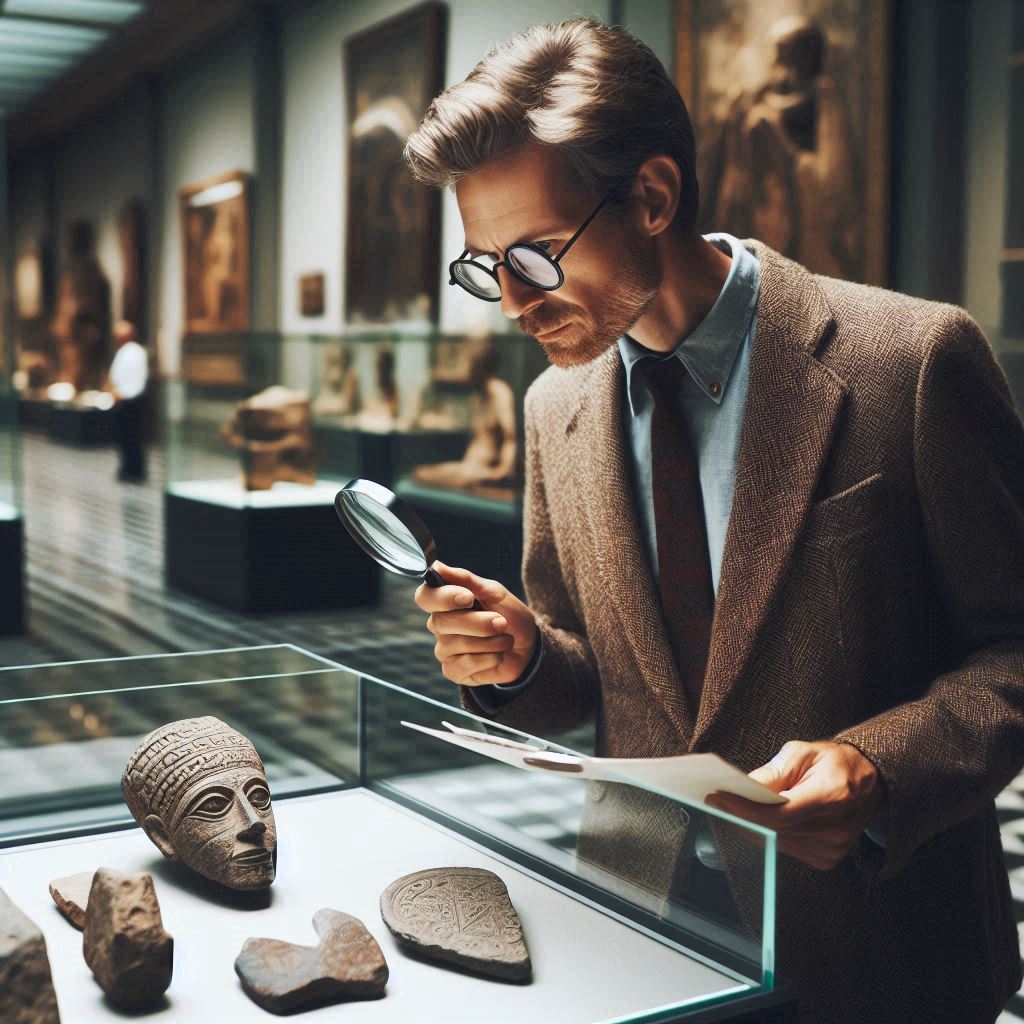
Shift towards community-centered curation
Increasing Emphasis on Involving Diverse Communities in Curation Processes
The shift towards community-centered curation reflects a growing recognition of the importance of diverse voices in the curation process.
Museums increasingly aim to involve local communities in decision-making and exhibition planning.
This approach acknowledges that art and culture are best understood within their social and cultural contexts.
Engaging diverse communities fosters a sense of ownership and connection to the museum.
By actively involving community members, curators can better represent their histories and narratives.
This collaborative effort leads to exhibitions that resonate more deeply with audiences.
It also empowers communities to share their stories and cultural expressions, breaking away from traditional top-down approaches.
Community-centered curation emphasizes inclusivity, allowing underrepresented voices to shape museum practices.
Curators are now prioritizing partnerships with local artists, activists, and cultural organizations.
This collaboration enriches exhibitions, bringing in a variety of perspectives that reflect the complexities of contemporary society.
Examples of Museums Implementing Community-Based Curation Practices
Several museums have successfully implemented community-based curation practices, showcasing the impact of this shift.
One notable example is the Smithsonian National Museum of the American Indian in Washington, D.C.
This museum actively collaborates with Native communities to ensure that exhibitions accurately represent their histories and cultures.
By involving indigenous voices, the museum creates meaningful narratives that honor their heritage.
Another example is the Peabody Essex Museum in Salem, Massachusetts.
This museum initiated the “Community Curators” program, which invites local residents to curate exhibitions based on their experiences.
Participants receive training and support, allowing them to share their unique perspectives through art and artifacts.
This initiative not only empowers community members but also fosters deeper connections between the museum and its audience.
The Birmingham Museum and Art Gallery in the UK has also embraced community-centered curation.
The museum launched the “Our Museum” project, which partners with local organizations to co-create exhibitions.
This project engages diverse communities in exploring their cultural heritage and highlights the importance of representation in museums.
The exhibitions created through this initiative reflect the rich tapestry of local histories, making them more relatable to visitors.
Moreover, the Museum of Contemporary Art Chicago (MCA) has adopted a community-centric approach to programming.
They regularly host community forums to gather input on exhibitions and educational initiatives.
This practice ensures that the voices of local artists and community members inform the museum’s direction.
The shift towards community-centered curation marks a significant transformation in the museum sector.
By emphasizing community involvement, museums create more inclusive and relatable exhibitions.
Read: How to Price Your Ceramic Artwork
Role of digital technologies in modern museum curation
Use of Virtual Exhibits and Interactive Displays
Digital technologies play a transformative role in modern museum curation.
Museums increasingly utilize virtual exhibits to reach broader audiences.
These online experiences allow visitors to explore collections from anywhere in the world.
Virtual tours, often accompanied by interactive elements, enhance engagement and accessibility.
Interactive displays also enhance the visitor experience within physical museum spaces.
Touchscreens, augmented reality (AR), and virtual reality (VR) enable visitors to engage with artworks more deeply.
For instance, AR apps can overlay historical information or multimedia content onto artifacts, providing richer context.
These technologies not only make exhibitions more engaging but also allow for personalized learning experiences.
Moreover, digital technologies facilitate educational programming and outreach.
Museums can host online workshops, lectures, and discussions, broadening their audience base.
By embracing digital platforms, curators can reach diverse demographics, including those unable to visit in person.
This shift expands the museum’s role as an educational resource, enhancing its relevance in today’s digital age.
Challenges and Opportunities Presented by Digital Curation
While digital curation presents many opportunities, it also poses significant challenges.
One challenge is ensuring that digital content accurately represents the physical collection.
Curators must carefully consider how to translate the physical experience into a digital format.
Balancing the authenticity of artifacts with interactive elements can be difficult.
Additionally, maintaining and updating digital platforms requires resources and expertise.
Many museums face budget constraints that limit their ability to invest in technology.
As a result, some institutions struggle to keep up with rapidly changing digital trends.
Ensuring that staff are trained to use these technologies effectively is crucial for successful implementation.
Another challenge involves accessibility.
While digital technologies can enhance accessibility, they can also create barriers.
Not everyone has access to high-speed internet or digital devices.
Curators must consider these factors when developing digital strategies.
This consideration ensures that all audiences can benefit from digital initiatives.
Despite these challenges, digital curation offers significant opportunities for innovation.
Museums can leverage data analytics to better understand audience preferences and engagement.
This insight allows curators to tailor exhibitions and programs to meet the needs of diverse visitors.
By using data, museums can enhance their relevance and improve the overall visitor experience.
Furthermore, digital technologies enable collaboration among institutions.
Museums can share resources, expertise, and collections, creating a more interconnected cultural landscape.
This collaboration fosters innovation and encourages cross-institutional exhibitions, expanding the reach of cultural heritage.
Digital technologies have profoundly impacted modern museum curation.
Virtual exhibits and interactive displays enhance visitor engagement and accessibility.
While challenges exist, such as resource constraints and accessibility issues, the opportunities for innovation and collaboration are immense.
Ethical considerations in museum curation
Repatriation of Stolen or Looted Artifacts to Their Countries of Origin
Ethical considerations play a crucial role in modern museum curation, particularly regarding the repatriation of stolen or looted artifacts.
Many museums house artifacts obtained during colonial periods or through unethical means.
These items often hold significant cultural and historical importance for their countries of origin.
The repatriation movement has gained momentum in recent years, driven by calls from indigenous communities and governments.
Advocates argue that returning artifacts acknowledges the cultural significance of these items and addresses historical injustices.
High-profile cases, such as the return of the Benin Bronzes and the Elgin Marbles, exemplify the ongoing debates surrounding repatriation.
Museums face ethical dilemmas in balancing the preservation of artifacts with the rightful claims of communities.
The process of repatriation requires transparent dialogue and cooperation between museums and the originating communities.
Institutions must develop policies that prioritize ethical practices and recognize the importance of cultural heritage.
Additionally, repatriation can foster trust and collaboration between museums and source communities.
By acknowledging past wrongs and working towards restitution, museums can play a role in reconciliation.
This collaborative approach enhances the museum’s mission to educate and share cultural histories respectfully.
Ethical Guidelines for Handling Sensitive Materials and Cultural Objects
In addition to repatriation, ethical guidelines for handling sensitive materials and cultural objects are vital in museum curation.
Curators must approach the presentation of culturally significant items with care and respect.
This includes understanding the cultural contexts and traditions associated with these objects.
Museums often hold sensitive materials that may be sacred or meaningful to specific communities.
Curators must seek guidance from these communities to ensure proper representation and care.
Engaging with cultural leaders and experts helps inform ethical practices in displaying and interpreting these materials.
Moreover, museums should establish clear policies regarding the acquisition of cultural objects.
Ethical guidelines must prioritize consent, collaboration, and cultural sensitivity.
Institutions should avoid acquiring items that lack provenance or come from exploitative sources.
This commitment to ethical sourcing fosters a culture of accountability within the museum sector.
Training staff in cultural sensitivity and ethical curation practices is essential.
Educating curators and museum professionals about the implications of their work promotes responsible stewardship.
Museums should also encourage ongoing discussions about ethical issues in curation.
This dialogue allows for continuous reflection and improvement in practices.
Lastly, museums must consider the diverse perspectives of their audiences.
Ethical curation involves presenting multiple viewpoints and interpretations of artifacts.
By doing so, institutions can foster inclusive narratives that honor the complexity of cultural histories.
Ethical considerations are fundamental to modern museum curation.
The repatriation of stolen or looted artifacts and the development of ethical guidelines for handling sensitive materials are crucial issues.
Museums must prioritize collaboration, transparency, and cultural sensitivity in their practices.
By doing so, they can uphold their responsibilities as stewards of cultural heritage and contribute to a more equitable understanding of history.
Ethical curation enhances the museum’s role as a space for learning, dialogue, and reconciliation.
Transform Your Career Today
Unlock a personalized career strategy that drives real results. Get tailored advice and a roadmap designed just for you.
Start NowFuture trends in museum curation
Integration of New Technologies Like AI and VR into Curation Practices
The future of museum curation is increasingly shaped by the integration of new technologies, such as artificial intelligence (AI) and virtual reality (VR).
These technologies offer innovative ways to enhance visitor experiences and improve curation practices.
AI can analyze large datasets to provide insights into audience preferences, enabling curators to tailor exhibitions more effectively.
By understanding what resonates with visitors, museums can create more engaging and relevant programming.
Additionally, VR technology allows museums to create immersive experiences that transport visitors to different times and places.
Virtual exhibitions enable audiences to explore collections without geographic limitations, broadening access to cultural heritage.
For instance, a virtual reality tour of ancient ruins or historical sites can offer a unique educational experience.
This technology not only engages viewers but also provides an opportunity for storytelling that traditional exhibits may lack.
Moreover, AI-powered chatbots can assist visitors in navigating exhibitions and answering questions.
These tools enhance visitor engagement by providing personalized information and recommendations.
As technology continues to evolve, curators will need to adapt their practices to incorporate these advancements effectively.
Training staff to utilize these tools is essential for maximizing their potential.
Sustainability and Inclusivity in Museum Exhibitions
Another significant trend in museum curation is the increasing emphasis on sustainability and inclusivity.
As awareness of environmental issues grows, museums are rethinking their practices to minimize their ecological footprint.
Sustainable curation involves selecting materials and methods that prioritize environmental responsibility.
This can include using energy-efficient lighting, sustainable display materials, and reducing waste in exhibitions.
Moreover, curators are also focusing on creating inclusive environments that reflect diverse perspectives.
Inclusivity in museum exhibitions means representing a wide range of voices, particularly those historically marginalized.
Curators are actively seeking to engage underrepresented communities in the curation process.
This collaborative approach not only enriches exhibitions but also fosters a sense of belonging among diverse audiences.
Incorporating community input into exhibition design ensures that diverse stories are told authentically.
Curators are forming partnerships with local artists and organizations to create exhibitions that resonate with various communities.
This shift towards inclusivity promotes a more comprehensive understanding of cultural narratives, breaking away from traditional Eurocentric perspectives.
Furthermore, museums are increasingly using exhibitions as platforms for social change.
They are addressing contemporary issues, such as climate change and social justice, through thoughtfully curated content.
By highlighting these topics, museums can encourage dialogue and inspire action among their audiences.
The future of museum curation is poised for exciting changes driven by technology and a commitment to sustainability and inclusivity.
Integrating AI and VR will enhance visitor engagement and broaden access to cultural heritage.
Simultaneously, focusing on sustainability and inclusivity will create more relevant and meaningful exhibitions.
As museums adapt to these trends, they will strengthen their roles as educational and cultural institutions in an evolving world.
Embracing these changes will ensure that museums remain vital spaces for exploration, learning, and community engagement.
Conclusion
The evolution of museum curation has undergone significant changes throughout history, reflecting broader societal transformations.
From the early days of collectors and scholars organizing artifacts to today’s sophisticated practices, museums have continuously adapted.
The shift from traditional displays to community-centered curation highlights the growing importance of inclusivity and representation.
Moreover, the integration of new technologies like AI and VR marks a pivotal moment in the field.
These advancements offer innovative ways to enhance visitor experiences and engagement.
Additionally, the emphasis on sustainability addresses pressing environmental concerns and aligns with contemporary values.
As museums navigate these changes, they play a vital role in shaping cultural narratives and fostering understanding among diverse audiences.
Adapting to evolving practices is essential for the benefit of all stakeholders.
Curators must remain open to new ideas and approaches, ensuring that museums serve as dynamic spaces for education and exploration.
By embracing inclusivity, sustainability, and technological advancements, museums can better meet the needs of their communities and audiences.
The future of museum curation lies in its ability to adapt and innovate.
By prioritizing the voices of marginalized communities and embracing new technologies, museums can continue to thrive as essential cultural institutions.
The ongoing evolution of curation promises to enrich the visitor experience and foster a deeper appreciation for our shared cultural heritage.
[E-Books for Sale]
The Big Book of 500 High-Paying Jobs in America: Unlock Your Earning Potential
$19.99 • 500 High-Paying Jobs • 330 pages
Explore 500 high-paying jobs in America and learn how to boost your career, earn more, and achieve success!
See All 500 High-Paying Jobs of this E-Book
1001 Professions Without a Degree: High-Paying American Jobs You Can Start Now
$19.99 • 1001 Professions Without a Degree • 174 pages
Discover 1001 high-paying jobs without a degree! Unlock career tips, skills, and success strategies for just $19.99!

